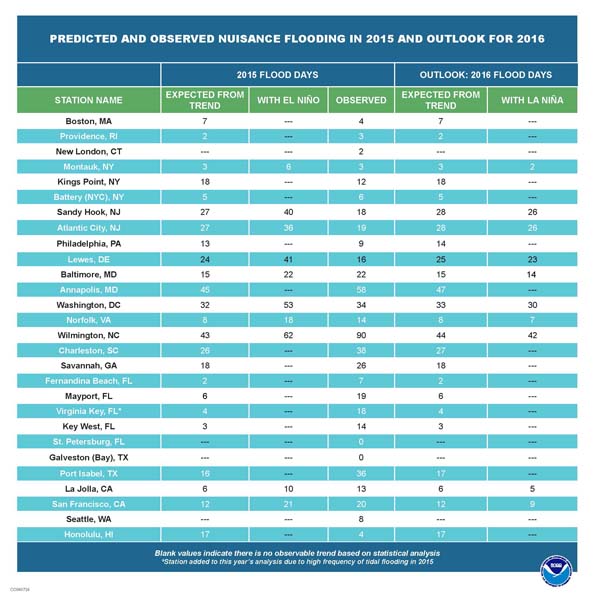The frequency of nuisance tidal flooding in many U.S. cities was predicted for the 2015 meteorological year, from May 2015 to April 2016, according to a new NOAA report.
Sure, records can be broken, but the existing records broke an old one too. El Niño has been misused and abused in forecasts and projections for decades. Some of the really glaring errors in the early days of climate change data were made because scholars with scant knowledge of complex statistics didn't control for El Niño, and that causes a lot more havoc than nuisance flooding. Nuisance flooding depends on multiple factors, including topography and land cover. The study defines nuisance flooding as a daily rise in water level above minor flooding thresholds set locally by NOAA weather forecasters and emergency managers for coastal areas prone to flooding.
Wilmington, North Carolina, saw an all-time high of 90 days of nuisance flooding, nearly one quarter of the year. Other cities with record numbers of flooding days are Charleston, South Carolina; Port Isabel, Texas; Mayport, Virginia Key, Key West, and Fernandina Beach, Florida, the report said. Some cities in the Mid-Atlantic and West Coast also experienced greater tidal flooding frequencies above normal trends, including Norfolk, Virginia; Baltimore, Maryland.
Not everywhere, though. Along the California coast, less than 10 days are expected at La Jolla and San Francisco, a decrease from 13 and 20 days observed in 2015, respectively.

These findings are a continuation of annual nuisance flooding monitoring and experimental predictions led by NOAA scientists William Sweet, Ph.D., and John Marra, Ph.D. The 2015 outlook, which covered the period between May 2015 through April 2016, indicated that mid-Atlantic and West Coast communities could experienced an increase over the trend in the number of nuisance flooding days due to likely higher sea levels during El Niño, which increases the reach of storm surges and high tides.
The new report, 2015 State of U.S. Nuisance Tidal Flooding, highlights nuisance flood during the 2015 meteorological year and compares it to the outlook at 28 NOAA tide stations around the United States, which have collected data for more than 50 years. It also provides a new outlook for the 2016 meteorological year, taking into account the La Niña conditions anticipated to develop in the coming months. La Niña typically has less effect on tidal flood frequencies compared to El Niño, however the nuisance flooding trend is still increasing.
The outlook for 2016 shows that the cities with the highest frequency of nuisance flooding will likely be:
- Annapolis, Maryland, with 47 days
- Wilmington, North Carolina, with 42 days
- Washington, D.C., with 30 days
- Charleston, South Carolina, with 27 days
- Atlantic City and Sandy Hook, New Jersey, with 26 days






Comments